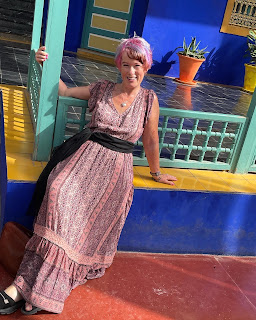On our recent trip to Marrakech,
we were fortunate to be able to take a hot air balloon trip. It was fantastic
and given the chance, it is something we both felt we would do again. However, I
wonder if like me, there are certain things you do, and you are glad you have
done it, but think it was a ‘once in a lifetime’ experience and never to
be repeated ever again. That was me yesterday. My beloved J, persuaded me to
join her on a 2-hour pony trek across the hills of Lancashire. She has been
riding now for two years and loves it. I, on the other hand, have never been on
a horse and don’t particularly like them. It’s a dislike that stems from my
time in Wales when the husband of one of my friends was killed by a kick to the
head from a Shire type horse.
In our house we take it in turns
to suggest doing something that the other person hasn’t tried before. For example,
for many years I was an enthusiastic and, if I say so myself, a pretty good
climber. J had never climbed, so by way of an introduction, I took her up Jake’s
Rake, a notorious scramble in the Lake District. It wasn’t a complete success.
She tells me and many others, she nearly died – but fair play, she tried it
once although is unlikely to do it again in a hurry.
Anyway, we pitched up at the stables
and were suitably kitted out with Hi Viz vests and riding hats. Other folk on the
trek had already had a horse selected for them and goodness, did they look tall.
In my eyes, with their feathered hooves, they all looked suspiciously like
Shire horses. Mine arrived. He was called Mac, and he looked big.
The sure footed horses gave rise to a
wonderful sense of confidence, as they picked their way up and down stony
gullies, across rivers and along country lanes.
Two hours later and we were back
at the stables. Young J was very excited by the experience. I was less enthusiastic.
But that is the thing about trying something out that the other person you are
with has never done before. She was happy, which made me happy. In the future J
will continue to ride and enjoy every moment; I will just keep on walking.
The month of August is drawing to
a close, and as with the last 7 years it has seen the brilliant, slightly
competitive We Active Challenge. You can read the history of the challenge here.
Over the 31 days of August, folk from all the many different health care
professions have walked, cycled, swam, run, spun and engaged in all kinds of physical
activities, yes even riding, and each day posted a picture of themselves, the
activity they are doing or simply an image that captures the spirit of their #weactive
challenge. We have all used the hashtag of our own health care profession to do
so. At the time of writing, it does look like those wonderful Allied Health
Professionals are likely to regain this year’s #WeActive top spot.
Like the #NHS1000Miles challenge,
more and more folk are joining in and sharing what they do to keep active, and
in so doing keeping healthy too. And that is the important thing. Yes, there
may be a little bit of a competitive edge, but it is about what you personally
can achieve, and importantly what that means for you. I set myself an #NHS1000Miles
target of walking 2,022 miles this year. I may or may not achieve this. However,
the 1,000 miles is just a target and lots of folk will get there this year. Some,
like our elite runners, will go way past this. Others will perhaps not reach
the 1,000 mile target, but for them will have still increased how much time
each day they are active. This is the whole purpose of both the #WeActive and
the #NHS1000Miles challenges.
The research tells us that active
people are healthier people. I don’t mean just physically healthier, but mentally
healthier too. And as the WHO tell us, ‘there is no health without mental
health’. It’s not just the huge body of research, or WHO, or even me that
is saying this; last week Maria Caulfield declared that ‘getting active is
hugely beneficial for both our mental and physical health, helping reduce
stress and ward off other illnesses, such as heart disease and obesity’.
I know what you are thinking.
Like you, I had no idea who Maria
was. Apparently, she was appointed Minister of State for Health on 7th
July this year. I rarely engage with politics in this blog, but I can’t help
feeling that this announcement (which was in the context of social prescribing)
is possibly going to be like my horse riding experience – a once in a lifetime occurrence.
I believe that it will be all of
us everyday folk that will make a difference to the health and wellbeing of the
communities we live in. Every step taken, every metre swum, miles cycled, horse
rides trotted, Km’s run during the #WeActive month of August will benefit not
just the individual, but all of us too. Let’s all keep on walking, or whatever
it is that you do in keeping active, and keeping healthy.



